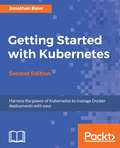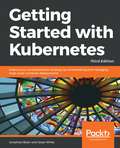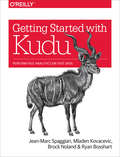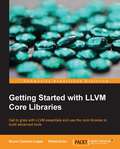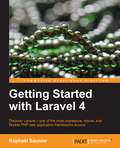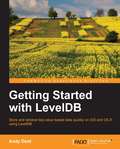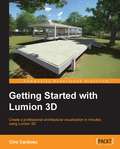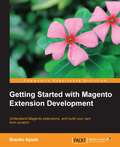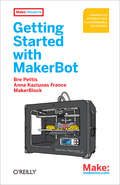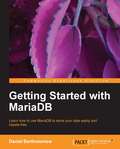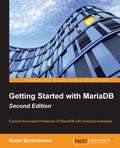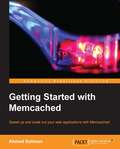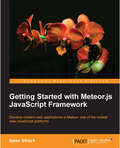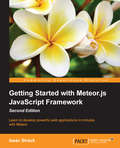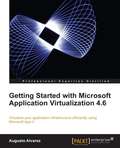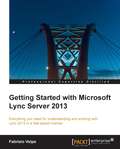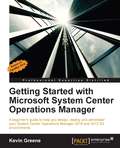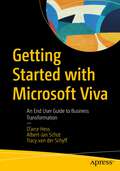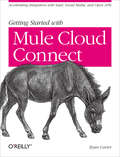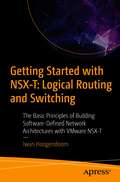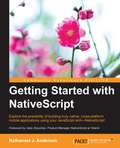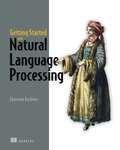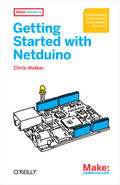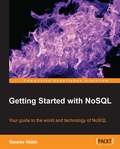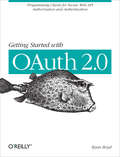- Table View
- List View
Getting Started with Kubernetes - Second Edition
by Jonathan BaierLearn how to schedule and run application containers using Kubernetes. About This Book • Get well-versed with the fundamentals of Kubernetes and get it production-ready for deployments • Confidently manage your container clusters and networks using Kubernetes • This practical guide will show you container application examples throughout to illustrate the concepts and features of Kubernetes Who This Book Is For This book is for developers, sys admins, and DevOps engineers who want to automate the deployment process and scale their applications. You do not need any knowledge about Kubernetes. What You Will Learn • Download, install, and configure the Kubernetes codebase • Understand the core concepts of a Kubernetes cluster • Be able to set up and access monitoring and logging for Kubernetes clusters • Set up external access to applications running in the cluster • Understand how CoreOS and Kubernetes can help you achieve greater performance and container implementation agility • Run multiple clusters and manage from a single control plane • Explore container security as well as securing Kubernetes clusters • Work with third-party extensions and tools In Detail Kubernetes has continued to grow and achieve broad adoption across various industries, helping you to orchestrate and automate container deployments on a massive scale. This book will give you a complete understanding of Kubernetes and how to get a cluster up and running. You will develop an understanding of the installation and configuration process. The book will then focus on the core Kubernetes constructs such as pods, services, replica sets, replication controllers, and labels. You will also understand how cluster level networking is done in Kubernetes. The book will also show you how to manage deployments and perform updates with minimal downtime. Additionally, you will learn about operational aspects of Kubernetes such as monitoring and logging. Advanced concepts such as container security and cluster federation will also be covered. Finally, you will learn about the wider Kubernetes ecosystem with OCP, CoreOS, and Tectonic and explore the third-party extensions and tools that can be used with Kubernetes. By the end of the book, you will have a complete understanding of the Kubernetes platform and will start deploying applications on it. Style and approach This straightforward guide will help you understand how to move your container applications into production through best practices and a step-by-step walkthrough tied to real-world operational strategies.
Getting Started with Kubernetes: Extend your containerization strategy by orchestrating and managing large-scale container deployments, 3rd Edition
by Jonathan Baier Jesse WhiteSchedule and run application containers using KubernetesKey FeaturesGet to grips with a wide range of tools to monitor and secure your deploymentsManage your container clusters and networks using KubernetesGet well-versed with the fundamentals of KubernetesBook DescriptionKubernetes has continued to grow and achieve broad adoption across various industries, helping you to orchestrate and automate container deployments on a massive scale.Based on the recent release of Kubernetes 1.12, Getting Started with Kubernetes gives you a complete understanding of how to install a Kubernetes cluster. The book focuses on core Kubernetes constructs, such as pods, services, replica sets, replication controllers, and labels. You will understand cluster-level networking in Kubernetes, and learn to set up external access to applications running in the cluster. As you make your way through the book, you'll understand how to manage deployments and perform updates with minimal downtime. In addition to this, you will explore operational aspects of Kubernetes , such as monitoring and logging, later moving on to advanced concepts such as container security and cluster federation. You'll get to grips with integrating your build pipeline and deployments within a Kubernetes cluster, and be able to understand and interact with open source projects. In the concluding chapters, you'll orchestrate updates behind the scenes, avoid downtime on your cluster, and deal with underlying cloud provider instability within your cluster.By the end of this book, you'll have a complete understanding of the Kubernetes platform and will start deploying applications on it.What you will learnDownload, install, and configure the Kubernetes code baseSet up and access monitoring and logging for Kubernetes clustersSet up external access to applications running in the clusterLearn how to manage and scale kubernetes with hosted platforms on AWS, Azure, and GCPRun multiple clusters and manage them from a single control planeDiscover top tools for deploying and managing a Kubernetes clusterLearn how to get production ready and harden Kubernetes operations, networking, and storageWho this book is forGetting Started with Kubernetes is for developers, system administrators, and DevOps engineers who want to automate the deployment process and scale their applications. No prior knowledge of Kubernetes is required.
Getting Started with Kudu: Perform Fast Analytics on Fast Data
by Jean-Marc Spaggiari Mladen Kovacevic Brock Noland Ryan BosshartFast data ingestion, serving, and analytics in the Hadoop ecosystem have forced developers and architects to choose solutions using the least common denominator—either fast analytics at the cost of slow data ingestion or fast data ingestion at the cost of slow analytics. There is an answer to this problem. With the Apache Kudu column-oriented data store, you can easily perform fast analytics on fast data. This practical guide shows you how.Begun as an internal project at Cloudera, Kudu is an open source solution compatible with many data processing frameworks in the Hadoop environment. In this book, current and former solutions professionals from Cloudera provide use cases, examples, best practices, and sample code to help you get up to speed with Kudu.Explore Kudu’s high-level design, including how it spreads data across serversFully administer a Kudu cluster, enable security, and add or remove nodesLearn Kudu’s client-side APIs, including how to integrate Apache Impala, Spark, and other frameworks for data manipulationExamine Kudu’s schema design, including basic concepts and primitives necessary to make your project successfulExplore case studies for using Kudu for real-time IoT analytics, predictive modeling, and in combination with another storage engine
Getting Started with LLVM Core Libraries
by Rafael Auler Bruno Cardoso LopesThis book is intended for enthusiasts, computer science students, and compiler engineers interested in learning about the LLVM framework. You need a background in C++ and, although not mandatory, should know at least some compiler theory. Whether you are a newcomer or a compiler expert, this book provides a practical introduction to LLVM and avoids complex scenarios. If you are interested enough and excited about this technology, then this book is definitely for you.
Getting Started with Laravel 4
by Raphaël SaunierThis book follows a practical and easy-to-follow approach and is packed with real-world examples to understand all the fundamentals and concepts in a very concise way. This book is ideal for web developers who want to get up to speed with Laravel quickly. You are expected to have some experience with the PHP programming language - or any C-like languages such as JavaScript, Perl, or Java - along with some understanding of basic OOP concepts. Any experience with MVC frameworks such as ASP.NET MVC or Ruby on Rails will certainly be beneficial but not required. Lastly, some familiarity with command line interfaces will also help but is not essential either.
Getting Started with LevelDB
by Andy DentThe book is a concise guide for using LevelDB. It explains database concepts and the use of C++, ranging from the basics all the way to high level topics in an easy to follow, step-by-step format.The book is meant for developers who want an embedded database for their applications. Experienced programmers can pick up on the sophisticated data mapping patterns and tuning tips. Getting Started with LevelDB requires a minimal background in programming in C++ or Objective-C for OS/X or iOS and familiarity with XCode. Therefore it teaches enough C++ to use LevelDB without presuming any C++ knowledge, so is suitable for beginner Objective-C programmers.
Getting Started with Lumion 3D
by Ciro CardosoA beginner's guide which flows from novice level discussion into intermediate level usage and finally helps the experts with tips and tricks."Getting Started with Lumion 3D" is the perfect book for someone without any experience in Lumion and who wants to start performing architectural visualization. It is also ideal for intermediate users who want to improve their workflow and learn techniques to get the best out of Lumion. This book is also useful for architects or designers who wish to see their projects come to life in natural environments with different moods and light conditions. You don't require complicated software for this book; if you have a 3D model, Lumion will do almost everything for you.
Getting Started with Magento Extension Development
by Branko AjzeleThis project-based tutorial gives you a strong foundation and guides you through practical, real-world examples.This book contains valuable insights for both newbies and already established Magento developers. This book is targeted at new and intermediate PHP developers starting afresh with Magento module development.
Getting Started with MakerBot: A Hands-On Introduction to Affordable 3D Printing
by Bre Pettis Jay Shergill Anna Kaziunas FranceReady to join the personal fabrication movement? This hands-on book shows you how to make a wide variety of physical objects with the amazing MakerBot 3D printer.It’s handy when you need a replacement for something lost, broken, or no longer made—like a knob on your stove. You can make things instead of buying them, or solve problems with inventions of your own. The possibilities are endless, and MakerBot is the fun, affordable, and inspiring way to go. Get started with your own little factory today!Set up your MakerBot Replicator 2 and understand how it worksLearn the basics and print 10 useful objects right awayMake objects with sturdy yet biodegradable PLAGet examples of real-world problem solving, from ceiling hooks to hermit crab shellsChoose from thousands of free designs on Thingiverse.com—and share your ownRepurpose disposable products by making them part of your designDesign your own 3D objects, using SketchUp, Autodesk 123D, OpenSCAD, and other toolsUse 3D scanning technology to replicate real objects around you
Getting Started with MariaDB
by Daniel BartholomewA practical, hands-on, beginner-friendly guide to installing and using MariaDB.Getting Started with MariaDB is for anyone who wants to learn more about databases in general or MariaDB in particular. No prior database experience is required. It is assumed that you have basic knowledge of software installation, editing files with a text editor, and using the command line and terminal.
Getting Started with MariaDB - Second Edition
by Daniel BartholomewThis book is for anyone who wants to learn more about databases in general and wants to get started with MariaDB. Prior database experience is not required.
Getting Started with Memcached
by Ahmed SolimanThis book is an easy-to-follow guide full of hands-on examples of real-world administration tasks, which will help you design and build highly scalable and very fast web applications.This book is ideal for web application developers looking for hands-on, practical, and to-the-point recipes to integrate the Memcached service into their day-to-day programming tasks. No prior knowledge of Memcached is assumed for using this book.
Getting Started with Meteor.js JavaScript Framework
by Isaac StrackWritten in an engaging, easy-to-follow style, "Getting Started with Meteor" is a practical guide for developing modern web applications with Meteor. This book is for developers or students who have a working knowledge of JavaScript and HTML, and want to learn how to quickly develop web applications using pure JavaScript. A basic understanding of traditional web server development and database methodologies will be helpful, but not necessary. Readers are expected to know how to program basic HTML pages and JavaScript functions, and be familiar with Terminal (basic Shell) commands.
Getting Started with Meteor.js JavaScript Framework - Second Edition
by Isaac StrackThis book is for developers or students who have a working knowledge of JavaScript and HTML, and want to learn how to quickly develop full-stack web applications using pure JavaScript.
Getting Started with Microsoft Application Virtualization 4.6
by Augusto AlvarezA practical tutorial containing clear, step-by-step explanations of all the concepts required to understand the technology involved in virtualizing your application infrastructure. By taking the reader through relevant real world examples that can be put into practice immediately, this book provides an easy way to plan and design the implementation. Each topic is written defining a common need and developing the process to solve it using Microsoft App-V.This book is written for IT professionals and IT decision makers who want to explore the benefits of implementing and maintaining virtual applications. If you are a system administrator or a consultant who wants to implement and administer App-V, then this book is for you. The detailed steps provided for applying App-V in your organization will work as an easy guide for IT professionals in charge of the operations. It will also meet the expectations of readers who are looking for a simple way of handling their infrastructure and who want to reduce the costs of help desk supports issues.
Getting Started with Microsoft Lync Server 2013
by Fabrizio VolpeThis book has a practical approach with a lot of step-by-step guides and explanations as to where and why we're doing the various operations.Getting Started with Microsoft Lync Server 2013 is a starting point for system administrators, IT pros, unified communication technicians, and decision makers in companies or in the consultancy business. For people who have never managed Lync (or a U.C. product), the book will guide you through the basic concepts and mistakes. If you are already managing a Lync deployment you will find important explanations and ideas put together in a single text. If your work requires evaluating a Lync project this book offers parameters and suggestions to plan a project to deliver the best results.
Getting Started with Microsoft System Center Operations Manager
by Kevin GreeneThe target audience for the book is the IT Pro or System Administrator who wants to deploy and use System Center Operations Manager but has no previous knowledge of the product.
Getting Started with Microsoft Viva: An End User Guide to Business Transformation
by D'arce Hess Albert-Jan Schot Tracy van der SchyffUse the power of analytics, knowledge management, and discovery for improved employee retention and insight to the unique collaborative and learning needs of your organization using Viva, Microsoft’s new employee experience platform. This book introduces you to the four central tenets of Microsoft Viva, a platform designed to improve communication, knowledge, learning, and insight within an organization. The authors, all Microsoft MVPs and early users of Viva, share their first-hand experiences and knowledge to teach you how to configure, utilize, and adopt Viva Topics, Viva Connections, Viva Learning, and Viva Insights to drive knowledge management and discovery within an organization. In Part I, you will learn how to classify data and topics within your organization, and learn how the use of AI can bring to life the discovery of knowledge and information related to people and other topics, allowing for better understanding and clarity of the content you see every day. In Part II, you will learn how to bring the power of SharePoint Syntex and Viva Topics into Microsoft Teams. In Part III, you will learn how to build a shared learning portal in Microsoft Teams using your own training materials, or bringing in third-party resources such as LinkedIn Learning and Skillsoft to connect directly to your employees. Managers will appreciate the ability to assign learning topics to users and gain the skills needed to create a fundamental process around learning consolidation. In Part IV, you will be introduced to Viva Insights, and understand how to discover vital analytics for individuals, managers, and leaders. You will also learn how it supports your company’s greatest asset, your employees. What You Will LearnUnderstand the basics of Viva to get up and running in no timeConfigure each vertical of Microsoft VivaKnow the roles and pre-requisites for installation and configurationOrganize and think about your content for discovery and relationshipsDeliver learning through an optimized experience for managers and usersLeverage the power of SharePoint within Teams using Viva Connections Who This Book Is For Management, end users, and system administrators who want to step up their knowledge management, better train and retain employees, and improve access to internal content. The book is designed for businesses that want to transform the way they learn about content and people within their organization, with the end objective of making their business grow and thrive.
Getting Started with Mule Cloud Connect: Accelerating Integration with SaaS, Social Media, and Open APIs
by Ryan CarterConnect your enterprise to a wide range of SaaS platforms, Open APIs, and social networks quickly and without difficulty. Through step-by-step instructions and numerous real-world examples, this concise guide shows you how to seamlessly integrate the external services you need with Mule ESB and its powerful Cloud Connect toolset.You’ll learn how to use service-specific connectors for many popular APIs—including Salesforce, Twitter, LinkedIn, and Twilio—through easy-to-learn abstractions. If Mule doesn’t have a connector for the resource you need, you’ll learn how to build your own. You’ll discover how easy it is to reach beyond the enterprise firewall for a host of Internet resources.Discover the advantages of using Mule Cloud Connect over typical web service clients and protocolsLearn how Cloud Connectors eliminate the need to understand the underlying API of each serviceGet started with the latest real-time technologies, including REST, WebHooks, and Streaming APIsIntegrate OAuth secure APIs and understand their role in authorization and information sharingDelve into advanced topics such as multi-tenancy and connection managementBuild your own custom connectors with the Mule DevKit
Getting Started with NSX-T: The Basic Principles of Building Software-Defined Network Architectures with VMware NSX-T
by Iwan HoogendoornThis primer on NSX-T helps you understand the capabilities and features of NSX-T, how to configure and manage NSX-T, and integrate NSX-T with other software. The book is the first in a series that will teach you the basics of NSX-T, which is an update of VMware's original software-defined networking (SDN) architecture aimed at making networks agile and flexible.You will become familiar with VMware's software-defined data center (SDDC) ecosystem and how NSX-T fits in. You will understand NSX-T components such as NSX-T Manager, NSX-T Edge Transport Nodes, and NSX-T Host Transport Nodes. And you will learn how to install and configure network services such as East/West and North/South routing capabilities, layer two switching, VRF, EVPN, multicast, and layer two bridging.The book provides best practices on how to configure routing and switching features, and teaches you how to get the required visibility of not only your NSX-T platform but also your NSX-T-enabled network infrastructure. The book explains security, advanced network features, and multi-site capabilities and demonstrates how network and security services can be offered across multiple on-premise locations with a single pane of glass for networking and security policy management. The interface with public cloud services is discussed and the book explains NSX-T operation in an on-premise private cloud and positioning and integrating NSX-T on a public cloud (off premises).What You Will Learn Understand how NSX-T fits in the VMware SDDC ecosystemKnow what NSX-T is, its components, and the terminology usedInstall NSX-TConfigure NSX-T network servicesManage the NSX-T networkWho This Book Is ForVirtualization administrators, system integrators, and network administrators
Getting Started with NativeScript
by Nathanael J. AndersonExplore the possibility of building truly native, cross-platform mobile applications using your JavaScript skill--NativeScript! About This Book * Save your marketing time by building for iOS, Android, and Windows Mobile platforms simultaneously * Be an ace at utilizing the features of NativeScript and its ability to communicate with each of the host device libraries natively * Proficiently, build your fully cross-platform communication application exhibiting the fundamentals of NativeScript Who This Book Is For If you are a JavaScript developer and want to build cross-platform applications, then this book is just the right one for you! What You Will Learn * Install and compile your application in NativeScript * Get important know-how on the NativeScript project structure * Develop and style your screens for multiple platforms * Create a full-featured cross-platform communication application * Import and use several third-party components * Simplify and deal with device resolution and cross-platform issues * Test and deploy your application In Detail NativeScript allows you to build a fast cross-platform application that has a native UI. NativeScript is a true cross-platform framework that generates native speed applications using the native components of the host platform, all using JavaScript. Although NativeScript allows you to build your application in JavaScript, you have full access to the host OS from your code, allowing you to easily tweak or use new platform features instantly at native code speeds. Whether you have already developed multiple applications or zero applications, this book will help you to develop your next application in a cross-platform framework quickly, saving you a massive amount of time and money. This book concisely shows you NativeScript's built-in framework that allows you to rapidly develop a fully-working compiled cross-platform application in just a few chapters. It starts by laying the foundation of NativeScript and working through the fundamentals to create a basic shell of the application. Moving on, you'll see how to build a full-fledged application step by step. We'll show you how to use plugins, and how to communicate with the native OS libraries easily so that you can customize your application as if your app was created in Java or Objective C. We then deal with the issues that arise from being cross platform and compensate for the different screen sizes, screen resolutions, and device abilities. Finally, we progress to testing and deploying your app. Style and approach A stepwise guide for building cross-platform mobile applications with the help of easy-to-understand examples.
Getting Started with Natural Language Processing: A Friendly Introduction Using Python
by Ekaterina KochmarHit the ground running with this in-depth introduction to the NLP skills and techniques that allow your computers to speak human. In Getting Started with Natural Language Processing you&’ll learn about: Fundamental concepts and algorithms of NLP Useful Python libraries for NLP Building a search algorithm Extracting information from raw text Predicting sentiment of an input text Author profiling Topic labeling Named entity recognition Getting Started with Natural Language Processing is an enjoyable and understandable guide that helps you engineer your first NLP algorithms. Your tutor is Dr. Ekaterina Kochmar, lecturer at the University of Bath, who has helped thousands of students take their first steps with NLP. Full of Python code and hands-on projects, each chapter provides a concrete example with practical techniques that you can put into practice right away. If you&’re a beginner to NLP and want to upgrade your applications with functions and features like information extraction, user profiling, and automatic topic labeling, this is the book for you. About the technology From smart speakers to customer service chatbots, apps that understand text and speech are everywhere. Natural language processing, or NLP, is the key to this powerful form of human/computer interaction. And a new generation of tools and techniques make it easier than ever to get started with NLP! About the book Getting Started with Natural Language Processing teaches you how to upgrade user-facing applications with text and speech-based features. From the accessible explanations and hands-on examples in this book you&’ll learn how to apply NLP to sentiment analysis, user profiling, and much more. As you go, each new project builds on what you&’ve previously learned, introducing new concepts and skills. Handy diagrams and intuitive Python code samples make it easy to get started—even if you have no background in machine learning! What's inside Fundamental concepts and algorithms of NLP Extracting information from raw text Useful Python libraries Topic labeling Building a search algorithm About the reader You&’ll need basic Python skills. No experience with NLP required. About the author Ekaterina Kochmar is a lecturer at the Department of Computer Science of the University of Bath, where she is part of the AI research group. Table of Contents 1 Introduction 2 Your first NLP example 3 Introduction to information search 4 Information extraction 5 Author profiling as a machine-learning task 6 Linguistic feature engineering for author profiling 7 Your first sentiment analyzer using sentiment lexicons 8 Sentiment analysis with a data-driven approach 9 Topic analysis 10 Topic modeling 11 Named-entity recognition
Getting Started with Netduino: Open Source Electronics Projects with .NET
by Chris WalkerStart building electronics projects with Netduino, the popular open source hardware platform that’s captured the imagination of makers and hobbyists worldwide. This easy-to-follow book provides the step-by-step guidance you need to experiment with Netduino and the .NET Micro Framework.Through a set of simple projects, you’ll learn how to create electronic gadgets—including networked devices that communicate over TCP/IP. Along the way, hobbyists will pick up the basics of .NET programming, and programmers will discover how to work with electronics and microcontrollers. Follow the projects in sequence and learn techniques for building your own Netduino-based devices.Get an overview of the Netduino microcontroller familyInstall the free Visual Studio Express, .NET Micro Framework, and Netduino SDKWrite code that lets you turn Netduino’s LED on and offLearn how to increase Netduino’s capabilities with various expansion shieldsMeasure digital and analog inputs with MakerShieldMake a light appear dimmer or brighter with Pulse Width ModulationUse electrical pulses to play a song and control the position of a servo motorCreate an app to control your Netduino over the Web
Getting Started with NoSQL
by Gaurav VaishAs with all Packt books this guide will use practical examples to impart information to the reader. Getting Started with NoSQL is a great resource for someone starting with NoSQL and an indispensable guide for technology decision makers. It is assumed that you have a background in RDBMS modeling and SQL and have had exposure to at least one of the programming languages - Java or JavaScript.
Getting Started with OAuth 2.0
by Ryan Boyd<p>Whether you develop web applications or mobile apps, the OAuth 2.0 protocol will save a lot of headaches. This concise introduction shows you how OAuth provides a single authorization technology across numerous APIs on the Web, so you can securely access users’ data—such as user profiles, photos, videos, and contact lists—to improve their experience of your application.</p>
